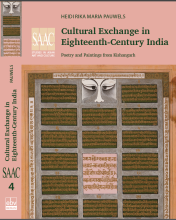This book studies the hybrid intellectual culture of eighteenth-century late-Mughal India, tracing the circulation of poetic and art styles between cosmopolitan Delhi and provincial centers. It presents a case study of the Rajput principality of Kishangarh, famous for its paintings, which were stylistically influenced by Mughal models, but thematically portrayed mostly the love play of the Hindu divinities Kriṣṇa and Rādhā.
What is not so well known is that Kishangarh was also a literary center, not only of the Kriṣṇa devotional poetry in Old Hindi (Braj Bhāṣā) that inspired several of its best-known paintings, but also of poetry in Old Urdu (Rekhtā), the new medium that was the rage in Delhi from the 1720s onward. This poetry too was illustrated in painting of a more calligraphic nature, as the one featured on the cover of this book (preserved at the Los Angeles County Museum of Art).
Highlighted in this book are the works of Sāvant Singh (1699-1764), alias Nāgaridās, who was a prolific poet in Braj Bhāṣā, as well as Rekhtā. In the first half of the eighteenth century, when he was the crown prince of Kishangarh, he commissioned the famous painter Nihālcand to illustrate his works. The book studies in detail this creative transformation of poetry in painting on the basis of newly discovered manuscript sources and paintings. It investigates these ‘provincial’ developments in the larger context of the circulation of painting styles and literary aesthetics in the Mughal empire, tracing continuities as well as ruptures with earlier ‘High Mughal’ trends in this ‘Late Mughal’ period on the eve of British influence.
